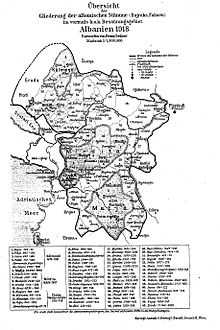Hoti (tribe)

Hoti is a Northern Albanian tribe and a historical tribal region of Malësia, located in northern Albania and southern Montenegro.[1]
History
The earliest known historical reference to the Hoti tribe was recorded in 1330, while in 1474 their region was mentioned in Latin sources as montanea ottanorum (English: Mountain of the Hotis).[2]
Before 1421, much of what is today known as "Malësia" was incorporated into the Lordship of Zeta ruled by the powerful Balšić family. According to the local oral history, in 1412-13, the Hoti tribe was engaged in a major dispute over the possession of grazing lands with the neighboring Mataguži tribe. Balša III was called to mediate the dispute. When he decided in favour of the Mataguži, the Hoti tribe attacked the Mataguži and took over the dipsuted areas. Shortly thereafter, a Mataguži counter-attack claimed the lives of four Hoti clansmen. After a long history of conflict with both the Ottomans and their (sometime) Venetian allies, the Balšići went extinct in 1421, after which the area came under control of Stefan Crnojević who fixed his capital at Žabljak on the north-eastern side of Lake Scutari and joined with his relative, the famous Scanderbeg, in many campaigns against the Turks.
In the second half of the 15th century (during the Ottoman conquest), Serbs of Bosnia were pushed southward by the Ottoman armies, eventually being pushed to Herzegovina by 1463. After the Ottoman conquest of Herzegovina in 1476, of Albania in 1478, and the surrender of Shkodër by the Venetians in 1479, according to legend, a man named Keq Preka and his four sons moved southward from the Herzegovinian highlands to escape the mass migration of Slavs. They and many of the other Albanian-speaking peoples in the Herzegovina area kept moving until they found an area where they found a population that spoke the same language as theirs (most likely a form of Gheg Albanian).[3]
At the outset of the northern Albanian resistance against Ottoman rule, the tribe of Hoti was credited with being the first of the northern Albanian clans to initiate the war for Albanian Independence. Of particular renown was the commander of the Albanian guerilla campaign against Turkish occupying forces, Ded Gjo Luli, perhaps Hoti's most distinguished hero. At the victorious Battle of Deçiq, Ded Gjo Luli was able to raise the Albanian standard in symbolic defiance of Ottoman rule (the Albanian standard had not been raised since the late fifteenth century, during the military campaigns of Scanderbeg). Because of its instrumental role in the resistance, Hoti is commonly held as the head the Albanian tribes of Malësia, and members of the tribe are routinely given places of honor at feasts even to this day.
The nearby Triesh tribe is considered by locals as the "younger brother" of Hoti, as the tribes share Keq Preka as a common ancestor. Hoti does not consider nearby {Triesh} as a "younger brother" they do not share Keq Preka since Hoti does not marry within Hot.
Religion
The majority of the Hoti are followers of the Roman Catholic faith and celebrate St. John the Baptist (Albanian: Shën Gjoni or Shnjoni) as their "feast" day. The day (August 29) commemorates the martyrdom (beheading) of Saint John the Baptist. There is also a significant minority in the region that follow Islam.
Geography
Hoti is divided into two subdivisions: Traboin and Rrapshë.[4] Rrapshë is divided into two, with one part belonging to Montenegro, and the other to Albania.
- Traboin / Trabojin
- Arza / Arrëz
- Helmnica / Helmnicë
- Škala / Shkallë
- Prenkaj
- Skorać / Skorraq
- Spinja / Spijë
- Trabojin / Traboin
- Stari Trabojin / Traboin Moçem
- Vatnikaj
- Vuksanlekići / Vuksanlekaj
- Rrapshë / Rapša (Montenegrin side)
- Drume
- Nikđonaj (Nikđokaj?)
- Hamala
- Božaj / Bozhaj
- Pothum / Nënhelm
- Drešaj / Dreshaj
- Mamaj (Mašaj or Mačaj?)
- Raza (Radza) / Raxë
- Vitoja / Vitojë
- Rrapshë (Albanian side)
Anthropology
There are two main branches of Hoti: Traboina (who are descended from Pjeter Gega) and Rapsha.[5]
Hoti are divided into the following families:[6][7][8]
- Camaj (Camovići)
- Dedvukaj (Dedvukovići)
- Drekaj
- Dushaj (Dušaj, Duševići)
- Gjelaj (Đeljaj, Đeljevići)
- Gjonaj (Đonaj, Đonovići)
- Gojçaj (Gojčaj, Gojčevići)
- Junçaj (Junčaj, Junčevići)
- Lajçaj (Ljajčaj, Ljajčevići)
- Nicaj (Nicovići)
- Prelvucaj
Notable tribesmen
- Ded Gjo Luli Dedvukaj, commander of the Malisori in the Battle of Deçiq
- Çun Mula Lucgjonaj/Junçaj, flag-bearer (bajraktar)
- Palok Traboini Gojçaj, secretary of Luli
Notable People
- Emina Cunmulaj (fashion model)
References
- ↑ Robert Elsie (19 March 2010). Historical Dictionary of Albania. Scarecrow Press. p. 193. ISBN 978-0-8108-7380-3. Retrieved 13 May 2013.
- ↑ Elsie, Robert; Mathie-Heck, Janice (2005). The highland lute: (Lahuta e Malcís) : the Albanian national epic. I.B.Tauris. p. 427. ISBN 978-1-84511-118-2. Retrieved 8 January 2011.
- ↑ Nopcsa, Franz (1925). Fiset e Malësisë së Shqipërisë Veriore dhe e drejta zakonore e tyre. Vienna,Austria: Qëndra Albanologjike. p. 196. ISBN 9789928110350.
- ↑ Jovićević 1923, p. 24-25
- ↑ Kenneth Bourne; David Stevenson; Donald Cameron Watt; John F. V. Keiger (1989). British Documents on Foreign Affairs--reports and Papers from the Foreign Office Confidential Print: Bulgaria, 1907-1914; Montenegro, 1895-1913. University Publications of America. p. 411. Retrieved 25 July 2013.
...the Hoti are divided into two branches, the Traboina and the Rapsha
- ↑ "Poreklo prezimena, selo Vuksanlekići (Podgorica)". Poreklo.rs (in Serbian). 12 April 2013. Retrieved 2 August 2014.
- ↑ "Poreklo prezimena, selo Sukuruć (Podgorica)". Poreklo.rs (in Serbian). 12 April 2013. Retrieved 2 August 2014.
- ↑ Jovićević 1923, p. 23-24
- ↑ 9.0 9.1 "Prezimena u Crnoj Gori" (in Montenegrin). Montenegrin Ethnic Association of Australia. Retrieved 2 August 2014.
- ↑ "Poreklo prezimena, selo Vladni (Podgorica)". Poreklo.rs (in Serbian). 12 April 2013. Retrieved 2 August 2014.